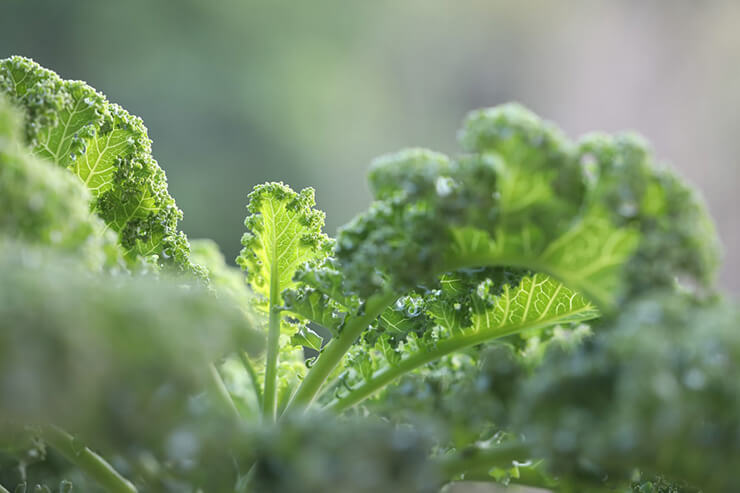Kale is a leafy green that thrives indoors just as well as it does in the garden. Known for its nutrient-dense leaves, kale has become a favorite among health-conscious eaters, urban gardeners, and anyone who enjoys growing their own food year-round. Its resilience, productivity, and vibrant texture make it a perfect crop for sunny windowsills, balconies, or under grow lights.
From curly to flat, green to purple, kale comes in many shapes and shades, adding both visual flair and variety to your meals. It’s packed with vitamins A, C, and K, as well as antioxidants, making it one of the most nutritious greens you can grow. Best of all, kale is a cut-and-come-again crop, meaning you can snip outer leaves and enjoy multiple harvests from each plant.
This leafy powerhouse thrives in containers, adapts to artificial light, and keeps growing as long as you keep picking. Whether you’re harvesting baby leaves for a fresh lunch salad or growing mature bunches for hearty dinners, kale delivers again and again.

Soil and pH Requirements
Kale is not fussy about soil, but it performs best in well-draining, nutrient-rich conditions.
- Ideal pH:Kale prefers a soil pH of 0 to 7.5—slightly acidic to neutral.
- Soil Type:Use a loose, well-aerated potting mix enriched with compost or aged manure.
- Fertilization:A balanced, slow-release fertilizer at planting and a light monthly feeding with liquid fertilizer helps keep foliage lush and flavorful.
Sunlight and Light Needs
Kale enjoys a bright environment, but it doesn’t demand intense light like fruiting plants.
- Light Duration:Provide 6-10 hours of light per day.
- Natural Light:A sunny windowsill or a spot near a south-facing window is ideal.
- Artificial Light:Full-spectrum grow lights work wonders in lower-light homes—keep them 6-12 inches above the plants and run them for 12-14 hours daily for best results.
Watering Guidelines
Consistent moisture is key to tender, non-bitter kale leaves.
- Watering Frequency:Water when the top inch of soil feels dry, typically every 2-4 days indoors.
- Best Practice:Water at the base of the plant to avoid wetting the leaves, which can lead to mildew or leaf spotting.
- Humidity:Average indoor humidity is fine. Mist occasionally in dry Winter air to prevent leaf curling.
Best Indoor Growing Environment
Kale is relatively unfussy and can adapt to a range of indoor conditions.
- Temperature Range:Kale prefers 60-75°F (15-24°C). It can tolerate cooler temps but grows more slowly in the cold.
- Containers:Use pots or troughs that are at least 6-8 inches deep. Make sure they have drainage holes.
- Spacing:Thin seedlings to 6-8 inches apart. If space is tight, harvest baby leaves early and often.
Kale Variety Spotlight: 5 Indoor Stars
Kale is versatile in the kitchen and easy to manage in small spaces. Unlike finicky crops, it can thrive in containers, under lights, and in a wide range of temperatures. Many kale varieties are compact enough to fit on a windowsill, and the plants bounce back quickly after harvesting. From smoothies to soups to crispy kale chips, this green is as flexible on the plate as it is in the garden.
Here are five popular kale varieties perfectly suited for growing indoors:
Dwarf Blue Curled
A petite version of the classic curled kale, this variety is ideal for containers. Its crinkly leaves are mild, tender, and visually appealing.
Indoor Perks:
- Compact, growing just 12-15 inches tall
- Tolerates lower light better than some other varieties
- Great for small containers or multi-plant setups
Best Uses:
- Massaged into fresh salads
- Sautéed with garlic and lemon
- Baked into kale chips
Red Russian
With flat, oakleaf-shaped leaves and purple veins, Red Russian is both beautiful and tasty. The leaves are softer and slightly sweeter than curly varieties.
Indoor Perks:
- Fast-growing, baby leaves harvestable in 25-30 days
- Tolerates cool rooms and varied light conditions
- Attractive enough to double as ornamental
Best Uses:
- Added to smoothies for a mild green boost
- Stirred into soups and stews near the end of cooking
- Flash-sautéed with olive oil and vinegar
Lacinato
Also called Tuscan or Black Kale, this variety has dark green, puckered leaves with a rich, earthy flavor. Its upright growth habit makes it space-efficient.
Indoor Perks:
- Tall, narrow profile fits small spaces
- Tolerates moderate humidity and air flow indoors
- Long harvest window—picks easily for months
Best Uses:
- Sliced into hearty grain bowls
- Blended into pesto or dips
- Braised in tomato or coconut-based sauces
Scarlet Kale
A stunning variety with deep purple-red leaves and ruffled edges. As temperatures drop, its color deepens and so does its flavor.
Indoor Perks:
- Adds color and texture to container gardens
- Highly ornamental and great for decorative pots
- Maintains vibrancy with sufficient light
Best Uses:
- Torn into raw salads for visual flair
- Sauteed with oil and garlic
- Paired with citrus and nuts in warm grain salads
Vates
Known for its densely packed, blue-green curly leaves, Vates is a reliable producer that resists bolting indoors and out.
Indoor Perks:
- Slow to bolt, even under variable indoor temps
- Dense growth in a compact footprint
- Responds well to regular harvesting
Best Uses:
- Chopped and stirred into pasta or risotto
- Used as a base for green wraps
- Mixed into egg dishes or savory muffins


 Previous
Previous

